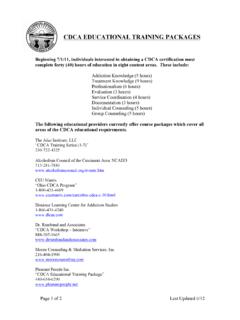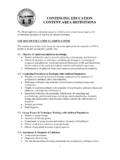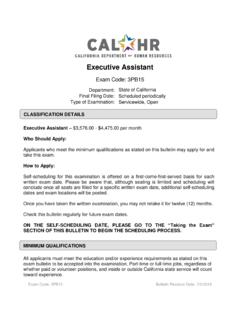Transcription of CHEMICAL DEPENDENCY COUNSELOR ASSISTANT …
1 Last Updated 03/17 CHEMICAL DEPENDENCY COUNSELOR ASSISTANT PHASE I EDUCATION GRID Please list, in chronological order, your CHEMICAL DEPENDENCY counseling education. To meet the requirements for CHEMICAL DEPENDENCY COUNSELOR ASSISTANT certification, applicants must document forty (40) hours of CHEMICAL DEPENDENCY specific education in the content areas listed below. The minimum number of hours in each area is identified. Fifty percent (50%) of this education must have been completed within the two (2) year period immediately prior to filing this application. Verification of all education hours listed must be included with this application. Acceptable forms of verification include official transcripts, certificates of attendance or letters of verification.
2 Indicate the number of hours in each content area for which the education/training applies. The content areas are as follows: 1 - Theories of addiction (5 hours) 2 - Counseling procedures & strategies with addicted populations (14 hours) 3 - Group process & techniques working with addicted populations (5 hours) 4 - Assessment & diagnosis of addiction (3 hours) 5 - Relationship counseling with addicted populations (0 hours) 6 - Pharmacology (0 hours) 7 - Prevention strategies (0 hours) 8 - Treatment planning (7 hours) 9 - Legal & ethical issues pertaining to CHEMICAL DEPENDENCY (6 hours) Date of training Title of training Total clock hours1234 5 6 789 TOTAL HOURS THIS PAGE One semester hour = 15 clock hours One quarter hour = 10 clock hours DUPLICATE THIS PAGE AS NEEDED AND INCLUDE WITH THE FORMAL APPLICATION Page 1 Last Updated 3/17 Definitions of CHEMICAL DEPENDENCY Specific Education Theories of Addiction Models and theories used to describe addiction, contemporary and historical Effects of addiction on individuals including the biological, psychological (cognitive and affective), social and spiritual dimensions of life and functioning.
3 The interaction of the social and cultural contexts with addictive processes Differentiation of addiction from other medical and psychological conditions Counseling Procedures and Strategies with Addicted Populations Theories of counseling and psychotherapy employed in the treatment of psychoactive substance abuse and addiction Techniques utilized in the treatment of psychoactive substance abuse and dependence Models of treatment utilized in the treatment of psychoactive substance abuse and addiction, contemporary and historical Interaction of theories of personality with theories of counseling and psychotherapy; professional issues including counter-transference, boundary setting and characteristics and dynamics which decrease the effectiveness of therapists Relapse prevention Dual diagnosis Group Process and Techniques Working with Addicted Populations Models of group therapy Dynamics of therapy groups Components of group process and analysis; dynamics of facilitation Effects of addictive processes on group therapy Effects of individual diversity of group process Assessment and Diagnosis of Addiction Assessment procedures Diagnostic interviewing Use and interpretation of testing instruments for psychoactive substance abuse and dependence Criteria for determining diagnosis.
4 Criteria for determining appropriate modality and level of treatment Use of collateral data in the assessment process, including professional and nonprofessional material Dual diagnosis Relationship Counseling with Addicted Populations Models and techniques of assessing relationship dysfunction Use and interpretation of instruments used in the assessment of relations Theories of counseling and psychotherapy employed in the treatment of dysfunctional relationships Techniques and strategies utilized in the treatment of dysfunctional relationships Effects of addictive processes on relationship systems Effects of addictive processes on human growth and development Page 2 Last Updated 3/17 Differential assessment of dysfunction resulting from codependency and other medical and psychological conditions Pharmacology Pharmacology of both drugs of abuse
5 And those used in detoxification and the treatment of addiction and mental and emotional disorders including the action of pharmaceuticals and the physiological response, the interaction of pharmaceuticals, tolerance, the appropriate use of psychotropics with addicted persons and the effects of drugs on sensation and perception, learning and memory, human growth and development, sexual functioning and behavior Prevention Strategies Models of prevention of psychoactive substance use, abuse and dependence, contemporary and historical Methods and components utilized in the interpretation of a needs assessment Function of evaluation instruments; social and cultural influences on the use of psychoactive substances Risk factors associated with the use, abuse and dependence on psychoactive substances Prevention and intervention strategies used with various groups identified by age, gender, ethnicity, sexual orientation, ability; employee assistance programming, student assistance programming Wellness Treatment Planning Models of treatment planning.
6 Adapting treatment strategies to individual needs and characteristics including persons with other medical and psychological conditions Criteria for admission, continuing care and discharge appropriate to diverse levels of treatment Methods of documenting the course of treatment Relapse prevention Legal and Ethical Issues Pertaining to CHEMICAL DEPENDENCY Principles supporting and informing the ethical codes pertaining to addictions counselors Specific knowledge of appropriate ethical codes and laws associated with addictions counseling Obligations and procedures which encourage the ethical conduct of counselors









